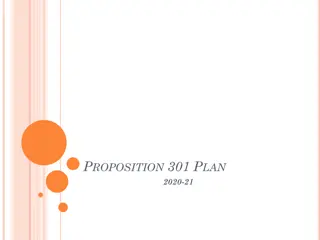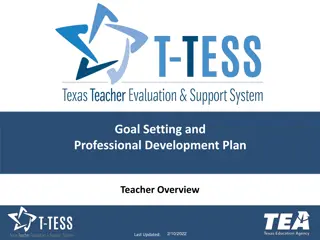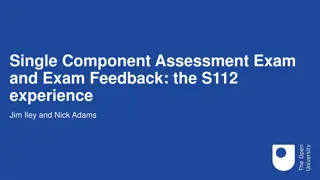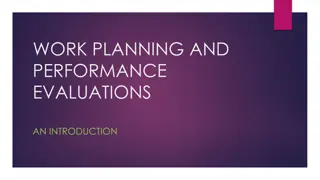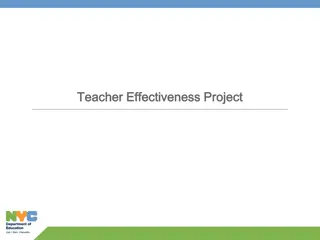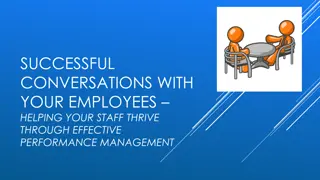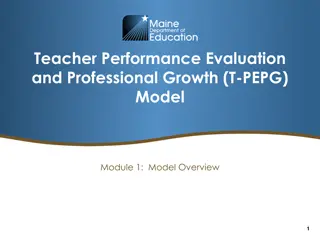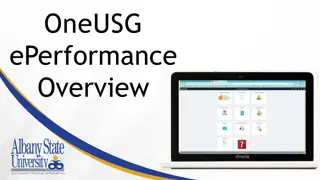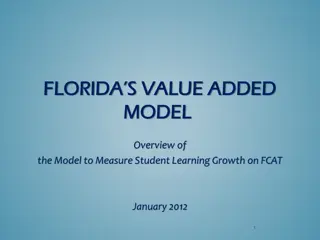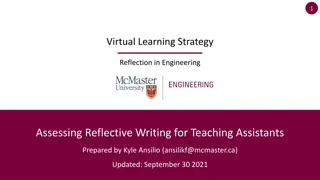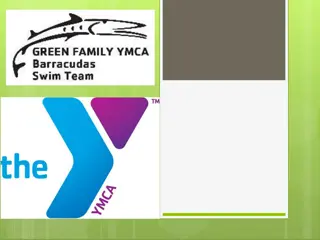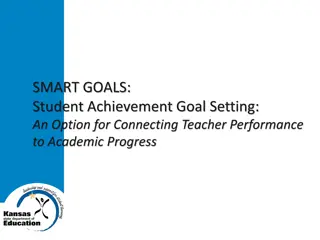Teacher Performance Evaluation and Professional Growth: Reflection and Goal Setting Module Overview
Explore the Teacher Performance Evaluation and Professional Growth (T-PEPG) Model Module 3, focusing on reflection, goal setting, and the development of SMART goals to enhance teaching practices and ensure student success. This module covers self-evaluation, setting professional goals, aligning goals with student learning objectives, and practical activities to support instructional planning. Participants will learn to complete accurate self-evaluations, set evidence-based goals, and prepare for continuous professional development.
Download Presentation

Please find below an Image/Link to download the presentation.
The content on the website is provided AS IS for your information and personal use only. It may not be sold, licensed, or shared on other websites without obtaining consent from the author.If you encounter any issues during the download, it is possible that the publisher has removed the file from their server.
You are allowed to download the files provided on this website for personal or commercial use, subject to the condition that they are used lawfully. All files are the property of their respective owners.
The content on the website is provided AS IS for your information and personal use only. It may not be sold, licensed, or shared on other websites without obtaining consent from the author.
E N D
Presentation Transcript
Teacher Performance Evaluation and Professional Growth (T-PEPG) Model Module 3: Reflection and Goal Setting 1
Module 3: Reflection and Goal Setting Module 1: Model Overview Module 2: Student Learning Objectives Module 3: Reflection and Goal Setting Participants engage in SMART goal development, a process to achieve or maintain effective practice and ensure students meet the rigorous learning targets established through the SLO process. SMART goals help strategically identify specific areas of growth and focus for the school year. Module 4: Evidence, Observation, and Feedback Module 5: Reflecting and Adjusting 2
Agenda Welcome (5 minutes) Connecting (15 minutes) SLOs and Professional Goals Learning (45 minutes) Sources of Evidence Overview of Self-evaluation and Goal Setting Process Mr. Brown s Reflection and Self-Evaluation SMARTer Goals Mr. Brown s Professional Goals Implementing (40 minutes) Practicing Self-evaluation and Goal Setting Reflecting and Wrap-Up (5 minutes) Submitting SLO and Professional Goals for Approval Preparing for Module 4 3
Intended Outcomes At the end of this session, participants will know and be able to Complete an accurate and evidence-based self-evaluation grounded in the MSFE Rubric Use evidence and the language of the MSFE Rubric to set SMART professional goals grounded in their student learning objectives 4
Connecting 20 MINUTES 5
Connecting SLOs and Professional Goals SLOs Learning goals for students Grounded in student data analysis and reflection Focused on instruction and assessment Professional Goals Learning goals for teachers Grounded in reflection and analysis of student needs Focused on adjusting and improving instruction to support student attainment of growth targets 6
Activity: Supporting Your SLO In pairs, share your SLO: What skills, knowledge, or structures do you need to implement the instructional plan effectively? What skills, knowledge, or structures do you need to support student attainment of growth targets? Identify 2-3 ways you could develop the skills, knowledge, or structures you discuss. 7
Learning 80 MINUTES 8
Evidence Collection Evidence can be collected through a variety of sources Classroom observations (live or through video) Observations of teacher collaboration Feedback conversations (pre- and post-observation) Teacher-collected evidence Student work 9
Types of Evidence Verbatim:Teacher: Students, please take out your notebooks. Numeric: 5 out of 10 student work assignments involved student choice. Factual summaries: The teacher asked the students to take out their notebooks. Observed aspects of the setting: Rules were posted. Or Slide presentation available on handouts. 10
Learning Activity 1a: Sources of Evidence Count off and go to the chart indicated by the facilitator Spend 3 minutes at that chart with your group Identify: Evidence statements for the source of evidence included on your chart Reminder: The most accurate evidence is objective, non-biased, and specific. When directed by the facilitator, move to the next chart 11
Wrap-Up/Debrief From Activity 1a Return to your original chart and determine if the statements of evidence are objective, non-biased, and specific. Read any statements that are not objective, non- biased, or specific to the group. 12
Self-Evaluation and Goal-Setting Step 1: Expectations and Goal- Setting Fall Step 2: Evidence, Feedback, and Growth Step 4: Professional Growth Plans Spring-Fall Fall-Spring Late Winter-Spring Step 3: Reflection and Rating 13
Self-Evaluation and Goal-Setting Step 1: Expectations and Goal-Setting Working in Professional Cohorts, teachers use the SLO framework to develop at least one measurable student growth target. Teachers engage in self-evaluation and professional goal setting Teachers seek review and approval of goals and expectations. 14
Connecting Student Learning and Professional Goals Professional Goal Setting Process Analysis of student data and student needs (a) Instruction, (b) Formative Assessment, (c) Instructional Adjustments Student Growth Targets Professional Growth Goals Self-evaluation and reflection using the MSFE Rubric and evidence 15
Activity: Mr. Browns Reflection and Self-evaluation At your table, assign 1-2 standard indicators to each person (Handout 3). Use the MSFE Companion Guide to answer the following questions for your standard indicators: Are the statements of evidence specific, objective, and non- biased? If not, how would you rewrite them to be? How well does Mr. Brown s evidence align with the identified standard indicators? How does Mr. Brown use his SLO to inform his reflection? What specific components does he reference? What other evidence or considerations might you recommend he include? What advice would you give Mr. Brown about strengthening his written reflection? 16
SMART Goals Description Questions to ask Specific Well-defined, clear outcome Clear to anyone who does not know anything about the project What do I want to accomplish? Measurable Know when it has been achieved How is achievement measured? How will I know it is accomplished? Attainable Achievable Agreement with stakeholders on what the goal should be How can it be accomplished? Relevant What are the urgent needs? Is the goal aligned with other projects? Is this the right time? Time-bound A specific date is set. Date is realistic. What can I do six weeks from now? The S.M.A.R.T. goal concept was introduced by G. T. Doran, A. Miller, and J. Cunningham in There s a S.M.A.R.T. Way to Write Management s Goals and Objectives, Management Review 70, no. 11 (1981), 35 36. What Makes a Goal S.M.A.R.T. ? also draws from the work of Ed Costa, Superintendent of Schools, Lenox, Massachusetts; John D Auria, a Lennox teacher; and Mike Gilbert, Northeast Field Director, Massachusetts Association of School Committees. 17
Learning Activity 2: SMART.er Goals Review Mr. Brown s SMART goals included on Handout 6 With a partner, identify how the goals can be made SMART-er 18
Wrap-Up/Debrief From Activity 2 How did you and your partner improve the example goals? Goal 1 Goal 2 Goal 3 19
Implementing 60 MINUTES 20
Implementing Activity: Setting Goals Use Handout 1, your SLO, and the Companion Guide to start the self-evaluation and reflection process. Draft a SMART professional practice goal using Handout 2. Ask a partner to provide you with feedback on the quality of your goal. Revise your draft goal. 21
Share Out Share 1 goal, the feedback you received, and how you modified your goal. 22
Reflecting and Wrap-Up 10 MINUTES 23
Reflecting Activity: 3-2-1 On Handout 7, write down 3 ideas you want to remember 2 things you learned today 1 outstanding question you have about the T- PEPG system 24
Next Steps: Submitting Your SLO and Professional Goals 1. Complete your professional goals, including: Appendix O. Professional Goal Setting Template, Part 2. Implementation Planning 2. Submit your SLO for pre-approval review 3. Submit your pre-approved SLO and professional goals for final approval. 25
Looking Forward to Module 4 Module 4 will provide details about the observation process, including: The collection and organization of observation evidence The sharing of timely, constructive feedback All participants participate in peer observation, and the module provides information about how to make the process meaningful, collaborative, and constructive. 26
Presenter name XXX-XXX-XXXX xxxxxxxxxxx@xxx.xxx 1234 Street Address City, State 12345-1234 27



